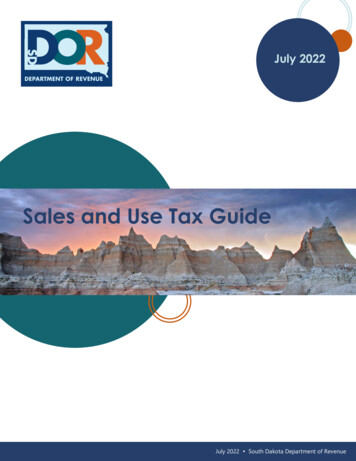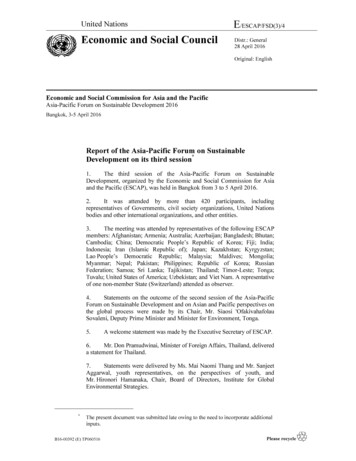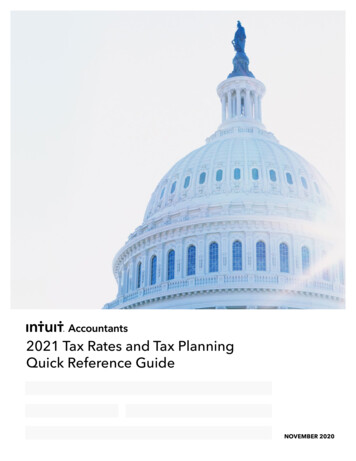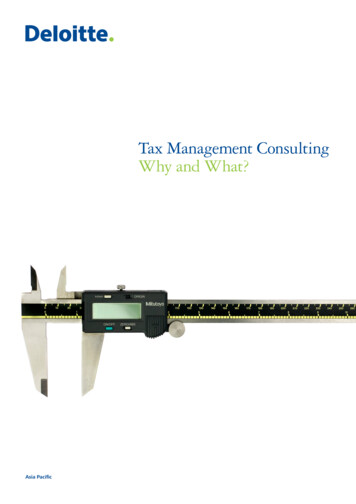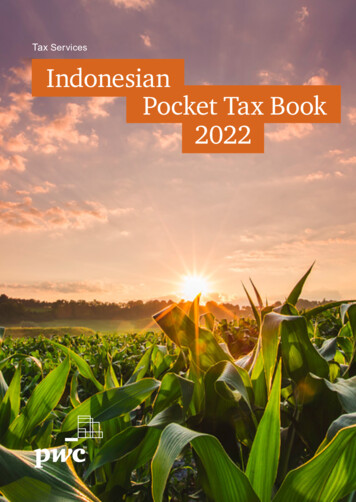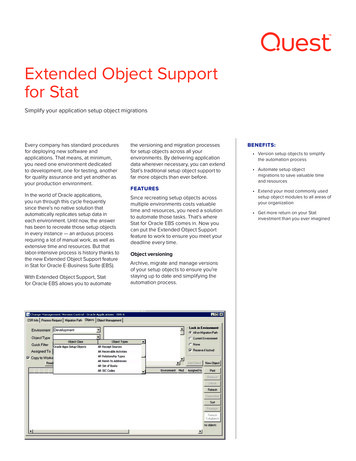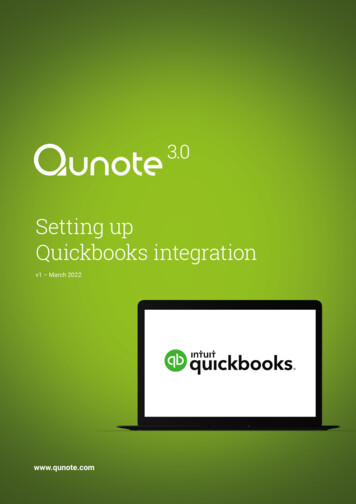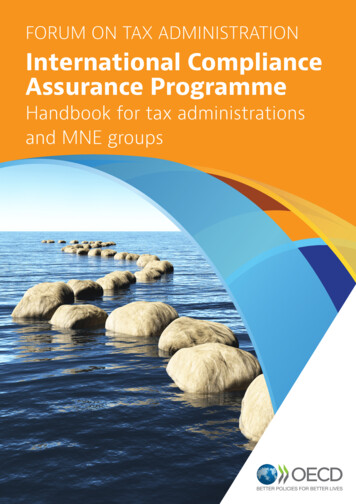
Transcription
FORUM ON TAX ADMINISTRATIONInternational ComplianceAssurance ProgrammeHandbook for tax administrationsand MNE groups
1International Compliance AssuranceProgrammeHandbook for tax administrations and MNE groupsINTERNATIONAL COMPLIANCE ASSURANCE PROGRAMME OECD 2021
2 This document, as well as any data and any map included herein, are without prejudice to the status ofor sovereignty over any territory, to the delimitation of international frontiers and boundaries and to thename of any territory, city or area.This document was approved by the Committee on Fiscal Affairs on 17 February 2021 and prepared forpublication by the OECD Secretariat.Please cite this publication as:OECD (2021), International Compliance Assurance Programme – Handbook for tax administrations and MNEgroups, OECD, ons-and-mne-groups.htmPhoto credits: TaiChesco – Shutterstock.com OCDE 2021The use of this work, ERNATIONAL COMPLIANCE ASSURANCE PROGRAMME OECD 2021
3Table of contentsAbbreviations and acronyms51 Introduction6The drivers for ICAPThe benefits from ICAPICAP and other tools to provide greater tax certainty6782 Overview of ICAP113 Suitability and scope144 The ICAP risk assessment and assurance process205 The role of participants in an ICAP risk assessment316 The ICAP documentation package367 Programme co-ordination41Stage I: SelectionStage II: Risk assessment and issue resolutionStage III: OutcomesSuitabilityScopeNotesStage I: SelectionStage II: Risk assessment and issue resolutionStage III: OutcomesNotesThe role of a lead tax administrationThe role of a covered tax administrationThe role of an MNE groupNotesThe selection documentation packageThe main documentation packageSupplementary documentationNotesICAP steering groupINTERNATIONAL COMPLIANCE ASSURANCE PROGRAMME OECD 202111121214141821242730313334353637393941
4 ICAP single point of contact41Annex A. Target timeframes for an ICAP risk assessment43INTERNATIONAL COMPLIANCE ASSURANCE PROGRAMME OECD 2021
5Abbreviations and acronymsAPAAdvance Pricing ArrangementBEPSBase Erosion and Profit ShiftingCbCCountry-by-CountryDTCDouble Tax ConventionFTAForum on Tax AdministrationICAPInternational Compliance Assurance ProgrammeJITSICJoint International Taskforce on Shared Intelligence and CollaborationLBIPLarge Business & International Programme of the FTAMAPMutual Agreement ProcedureMLIMultilateral Convention to Implement Tax Treaty Related Measures to Prevent BEPS (theMultilateral Instrument)MNEMultinational EnterpriseOECDOrganisation for Economic Co-operation and DevelopmentPEPermanent establishmentSPOCSingle Point of ContactTIEATax Information Exchange AgreementTPTransfer pricingUPEUltimate Parent EntityINTERNATIONAL COMPLIANCE ASSURANCE PROGRAMME OECD 2021
6 1 Introduction1.The International Compliance Assurance Programme (ICAP) is a voluntary programme for amultilateral co-operative risk assessment and assurance process. It is designed to be an efficient, effectiveand co-ordinated approach to provide multinational enterprise groups (MNE groups) willing to engageactively, openly and in a fully transparent manner with increased tax certainty with respect to certain oftheir activities and transactions. ICAP does not provide an MNE group with legal certainty as may beachieved, for example, through an advance pricing arrangement (APA). It does, however, give comfort andassurance where tax administrations participating in an MNE group’s risk assessment consider coveredrisks to be low risk. Where an area is identified as needing further attention, work conducted in ICAP canimprove the efficiency of actions taken outside the programme, if needed.2.ICAP was first launched in January 2018 with a pilot including eight tax administrations. A secondpilot with 19 tax administrations was announced in March 2019. This handbook incorporates experiencefrom these two pilots. The handbook remains a working document and may be revised periodically basedon the experience of participating tax administrations and MNE groups.The drivers for ICAP3.There are six key drivers behind the development of the ICAP risk assessment and assuranceprocess, set out below. Some of these concern the imperative for mechanisms to provide greater certaintyfor MNE groups and tax administrations, building on the outcomes of the Organisation for Economic Cooperation and Development (OECD)/G20 Base Erosion and Profit Shifting (BEPS) Project and theestablishment of the OECD Inclusive Framework on BEPS. Others concern the trend for greatercollaboration and co-operation between different tax administrations, and between tax administrations andMNE groups, which supported the development of such mechanisms. Providing a pathway to improved tax certainty for MNE groups: Multilateral programmes canprovide a pathway to greater international tax certainty for MNE groups and tax administrationsalike, and are a positive outcome from the BEPS project for MNE groups that are willing to engageactively, openly and transparently. They are also a reflection of the G20’s agenda on tax certainty– a pillar of the G20's work on international taxation that is both part of and supplements the workon BEPS. 1 Programmes such as ICAP, which are based on increased transparency, co-operationand collaboration between tax administrations and MNE groups, have the potential to positivelyinfluence taxpayer behaviour and improve tax compliance, while providing MNE groups withgreater tax certainty. More effective dispute resolution: More efficient and effective mutual agreement procedures(MAP) are being implemented as a result of BEPS Action 14. A multilateral risk assessment andassurance programme can support these dispute resolution initiatives by preventing unnecessarydisputes from arising and limiting MAP inventory growth. One of the most effective ways to managethe risk of disputes between tax administrations is through mechanisms to prevent these disputesfrom arising.INTERNATIONAL COMPLIANCE ASSURANCE PROGRAMME OECD 2021
7 Well-established MNE group compliance frameworks: The OECD's Forum on TaxAdministration (OECD FTA) has identified, developed and highlighted best practices in the areasof co-operative compliance, joint audits, tax control frameworks, and differentiated riskmanagement. As a result, tax administrations are better equipped than ever to bring theseinitiatives and standards together and explore new approaches for multilateral tax risk assessmentand assurance. Early resolution programmes prevent positions becoming entrenched and, bybeing done close to “real time”, can be undertaken while contemporaneous documentation, keydecision makers, and staff with knowledge and understanding of recent transactions, are available. Advances in international collaboration: Co-operation amongst OECD FTA member taxadministrations has vastly increased both in depth and in frequency in recent years. Welldeveloped forums, such as the Joint International Taskforce on Shared Intelligence andCollaboration (JITSIC) 2 and the Large Business and International Programme (LBIP) 3 are alreadyin place and can be leveraged to support multilateral interactions with MNE groups. Better and more standardised information for transfer pricing risk assessment: As a resultof BEPS Action 13, tax administrations now have access to an increasingly common set of data toassess transfer pricing and other BEPS-related risks, across multiple jurisdictions. Workingtogether to use the information contained in an MNE group's CbC report, master file and local filesmore effectively, tax administrations may jointly de-select compliance issues and taxpayers whichpose a lower tax risk, while selecting for further review those issues and taxpayers that present ahigher risk of non-compliance. Capitalising on greater opportunities for multilateral engagement to provide improvedassurance for tax administrations: Following the BEPS Project, tax administrations have agrowing volume of data available to them that can be used to identify and respond to compliancerisk in a more efficient way. Multilateral programmes can provide additional assurance toparticipating tax administrations by providing a more robust and considered basis for riskassessment using this data, allowing decisions to be made in consultation with other taxadministrations rather than unilaterally.The benefits from ICAP4.As tax administrations and MNE groups enter an era of increased transparency, new opportunitiesarise to use the increased flow of information to support open, co-operative relationships betweentaxpayers and tax administrations, providing routes towards greater comfort or certainty, and a moreeffective use of resources. ICAP uses CbC reports and other relevant information to facilitate multilateralengagements between MNE groups and participating tax administrations, providing benefits for both,including the following. Fully informed and targeted use of CbC reports and other information held for riskassessment: ICAP enables MNE groups to talk through their CbC reports and other informationheld by tax administrations for the purposes of risk assessing covered risks, and to provideadditional clarity to aid understanding of their cross-border activities. Tax administrations are alsoable to discuss their findings with each other, improving consistency in the interpretation of data.This should help tax administrations to reach an early decision about the level of tax risk, if any,presented by the data contained in these documents. It may also improve consistency in theunderstanding of MNE groups with similar transactions in multiple jurisdictions. An efficient use of resources: Tax administrations discuss the information provided by an MNEgroup for its ICAP risk assessment, share their findings with each other and co-ordinate any followup questions. An MNE group can thus engage with several tax administrations simultaneously,INTERNATIONAL COMPLIANCE ASSURANCE PROGRAMME OECD 2021
8 either through multilateral engagements or via the lead tax administration, rather than needing todeal with multiple separate enquiries. A faster, clearer route to multilateral tax certainty: ICAP is a managed process with clear andambitious timeframes, which are agreed upfront, for MNE groups and tax administrations to reacha mutual understanding of the level of tax risk present. Working multilaterally, tax administrationsgain a comprehensive picture of an MNE group’s cross-border activities and can be assured eitherthat the tax position is satisfactory or that any tax risk has been identified. In the spirit of cooperative compliance, this is communicated clearly to the MNE group at an early stage. Theprocess also provides an MNE group with an opportunity to use insights from ICAP more broadlyin managing its affairs across its global operations. Co-operative relationships between MNE groups and tax administrations: ICAP includes acommitment by MNE groups and tax administrations to work together through the ICAP riskassessment and assurance process in a transparent, open and co-operative manner. As a resultof participation in the programme, a relationship of mutual trust based on reciprocal openness andgood faith may be generated. Fewer disputes entering into MAP: Mechanisms for a more co-operative and collaborative riskassessment and assurance of MNE groups should improve how tax administrations understandthe perception and treatment of transactions by other tax administrations. They also provide anopportunity for tax administrations to discuss transactions at the risk assessment stage, beforediffering views are adopted and become entrenched. This can improve consistency between taxadministrations in the interpretation and treatment of transactions, reducing the number ofinstances where a case results in dispute and MAP.ICAP and other tools to provide greater tax certainty5.ICAP is one of a suite of tools available to tax administrations to provide greater certainty to MNEgroups with respect to their tax risk. These include: tools to provide upfront legal certainty for specific transactions or arrangements, including APAs tools to improve effective tax risk assessment, including standardised risk assessmentdocumentation under BEPS Action 13 tools to improve effective tax audit, including global awareness training to improve domesticprocesses for the audit of international tax risks and programmes for the simultaneous or joint auditof MNE groups tools to improve effective dispute resolution, including improvements to MAP under BEPS Action14 and mandatory binding arbitration such as under the multilateral convention to implement taxtreaty related measures to prevent BEPS (the MLI).6.The FTA LBIP and the FTA MAP Forum undertake a range of work, separately and jointly, toprovide greater certainty for tax administrations and taxpayers through more effective tax disputeprevention and resolution.ICAP compared to other tools7.Not all of the tools mentioned above will be suitable for every MNE group and for every risk. Insome cases, a particular approach will not be available in a particular jurisdiction or for certain types oftransaction. Where different approaches are possible, an MNE group may take into account differentfactors to determine which is most suitable.INTERNATIONAL COMPLIANCE ASSURANCE PROGRAMME OECD 2021
9The level of certainty required: As a risk assessment tool, ICAP may provide an MNE group withcomfort that a covered tax administration does not anticipate that compliance resources will bededicated to a further review of covered risks for a defined period. ICAP does not provide an MNEgroup with the type of legal certainty that may be obtained through other bilateral or multilateralroutes, such as a bilateral or multilateral APA, simultaneous or joint tax audit or MAP/arbitration(see below).The risks and jurisdictions with respect to which uncertainty exists: Under ICAP, an MNEgroup may obtain comfort that multiple covered tax administrations do not anticipate dedicatingcompliance resources to a further review of the covered risks. A covered tax administration mayprovide comfort on a covered risk, from its own perspective, even in cases where the other side ofthe covered risk is in a non-participating jurisdiction. This is wider than the scope of most APAsand MAP cases, and many audits, which may provide certainty with respect to specific transactionsor categories of transactions, with particular jurisdictions.The level of documentation an MNE group is prepared to provide: The ICAP documentationpackage is set out in Chapter 6. The level of documentation required for an ICAP risk assessmentis less than that typically needed in order to agree an APA or in the course of a tax audit or MAPwith respect to covered transactions. In addition, under ICAP an MNE group is able to provide asingle documentation package for use by all covered tax administrations, whereas it may berequired to prepare different documents in each jurisdiction under domestic programmes.The amount of time an MNE group is prepared to spend: ICAP includes a clear timeframe andtypically an MNE group’s ICAP risk assessment will be completed and outcome letters issuedwithin 24-28 weeks following delivery of the main documentation package, at the start of the riskassessment and issue resolution stage. Reflecting differences in terms of the level ofdocumentation typically required and the level of certainty provided, this timeframe is shorter thanmay be required to agree an APA, or for completion of a tax audit or MAP case.The extent to which early certainty is required: An ICAP risk assessment focuses on an MNEgroup’s recent completed fiscal period/s for which information, including the MNE group’s CbCreport, is available. This will often be undertaken sooner after the end of the covered period thanwould be possible for a tax audit, and will certainly be sooner than would be possible under disputeresolution mechanisms such as MAP.INTERNATIONAL COMPLIANCE ASSURANCE PROGRAMME OECD 2021
10 ICAP as a complement to other tools8.Reflecting the differences highlighted above, ICAP is a complement to other tools that taxadministrations may use to improve tax certainty for MNE groups, both unilaterally and multilaterally. Domestic tax audit: Even where a tax administration is unable to conclude that a coveredtransaction is low risk, it may be the case that no further compliance action is needed. Where a taxaudit is required, the improved risk assessment conducted through ICAP and the betterunderstanding of an MNE group, its business and its activities gained from participation in theprogramme, should enable the tax administration to conduct a more effective audit, which may becompleted more quickly and with less additional documentation needed. Bilateral/multilateral APAs and joint/simultaneous audit: By introducing multilateralconversations with an MNE group at the risk assessment stage, ICAP may also facilitate furthermultilateral action where this would be beneficial. This could include MNE groups better identifyingcovered transactions as suitable for a bilateral or multilateral APA. It could also include coveredtax administrations conducting joint or simultaneous tax audits, where they agree that a particularcovered transaction requires further attention. In each case, the conversations that the covered taxadministrations have already had during the ICAP process, and the better understanding they haveof the MNE group and of each other’s position, can improve the effectiveness of these actions. MAP: As mentioned above, programmes such as ICAP can also improve consistency between taxadministrations in the interpretation and treatment of transactions, reducing the number of casesthat result in disputes that require resolution through MAP.NotesThe OECD/IMF Report on Tax Certainty for G20 Finance Ministers and Central Bank Governorswas published on 18 March 2017. This report explores the nature of tax uncertainty, its main sources andeffects on business decisions and outlines a set of concrete and practical approaches to help policymakersand tax administrations shape a more certain tax environment. The report outlines a set of concrete andpractical approaches and solutions to enhance tax certainty in G20 and OECD countries including throughdispute prevention and early issue resolution programs, such as co-operative compliance programs andadvance pricing arrangements (APAs), as well as simultaneous and joint ertainty.htm).1JITSIC brings together 42 national tax administrations and offers a platform to enable its membersto actively collaborate within the legal framework of bilateral and multilateral conventions and taxinformation exchange agreements.2The Large Business and International Programme (LBIP) of the FTA brings together 46 membercountries to develop frameworks, information and other tools to improve tax administrations individual andcollective capacity to manage international tax risks. The LBIP currently provides the umbrella under whicha number of complimentary projects, focused on tax risk assessment and assurance as an area formultilateral action, are being carried forward i.e. ICAP, Comparative Risk Assessment and Joint Audits.Together with the FTA MAP Forum, the LBIP is currently undertaking further work on improving the APAprocess, opportunities for the greater use of multilateral APAs and MAP, and the wider use of standardisedbenchmarking in common transfer pricing situations.3INTERNATIONAL COMPLIANCE ASSURANCE PROGRAMME OECD 2021
112 Overview of ICAP9.An MNE group’s ICAP risk assessment comprises a number of stages, which are set out belowand described in more detail in Chapter 4. A diagram illustrating the anticipated timeframe for these stagesis included in the Annex to this handbook.10.MNE groups interested in participating in ICAP are encouraged to approach their potential leadtax administration before formally submitting any documents. This initial process would be to discuss theirparticipation in the programme, what is involved in the process, the outcomes they can expect, 1 andwhether they would be a suitable candidate at that time.Stage I: Selection11.The selection stage serves two functions. First, it provides a simple, cost-effective way for MNEgroups to learn which tax administrations are able and willing to take part in their ICAP risk assessment.Second, it provides an opportunity for the lead tax administration and other covered tax administrations toreview a high level summary of all of the MNE group’s transactions relevant to the covered risks anddetermine whether any should be excluded from the scope of their ICAP risk assessment.12.This stage begins when an MNE group submits its selection documentation package, as describedin Chapter 6, to its potential lead tax administration. This includes items that an MNE group will typicallyalready hold (e.g. its most recent CbC report and master file) or that involve the completion of standardICAP templates provided by the lead tax administration. The ICAP templates allow an MNE group toindicate its preferences as to which tax administrations would be covered tax administrations for its ICAPrisk assessment. These preferences will be taken into account by tax administrations in consideringwhether they will participate as covered tax administrations in a risk assessment, but are not determinative.To facilitate planning and co-ordination across different ICAP risk assessments, the dates of periodicdeadlines for MNE groups to submit this package are included on the OECD website. These dates will beapplied by all tax administrations participating in ICAP.13.If the tax administration is willing to act as lead tax administration, it will review the selectiondocumentation package for completeness. The documentation package is then provided to other taxadministrations that participate in ICAP and are in jurisdictions where the MNE group has constituententities. In some cases, the lead tax administration may contact potential covered tax administrations priorto circulating the selection documentation package, to make preliminary enquiries as to their potentialinterest in participating in a risk assessment. A participating tax administration that already knows it is notin a position to be a covered tax administration for a particular risk assessment (e.g. taking into accountother ICAP risk assessments it is undertaking) may make this clear to the lead tax administration at thispoint. Otherwise, the selection documentation package will be provided to all participating taxadministrations in jurisdictions where the MNE group has one or more constituent entities. Multilateral callswill be held between these tax administrations to determine which of them will participate in the MNEgroup’s ICAP risk assessment. Tax administrations will also decide on any transactions that should beexcluded from the scope of that risk assessment, for example because they are already covered by anAPA. Tax administrations that will participate in the MNE group’s ICAP risk assessment will also agree theINTERNATIONAL COMPLIANCE ASSURANCE PROGRAMME OECD 2021
12 target timeframe for the risk assessment stage and any changes that are required to the standard maindocumentation package described in Chapter 6.14.The outcomes of these discussions will be fed back to the MNE group, which will decide whetherit wishes to proceed to the risk assessment stage with the covered tax administrations that have indicateda willingness to participate, and the scope and terms of its ICAP risk assessment as described.15.The target timeframe for the selection stage is four to eight weeks from receipt of the selectiondocumentation package.Stage II: Risk assessment and issue resolution16.The risk assessment and issue resolution stage (also referred to as simply the “risk assessmentstage”) is at the heart of ICAP, and involves a multilateral risk assessment and assurance of the coveredrisks by the lead tax administration and other covered tax administrations. This stage begins with thesubmission of the main documentation package by the MNE group. In most cases, the risk assessmentstage will include at least one multilateral call or meeting between the MNE group, the lead taxadministration and other covered tax administrations, with further calls or meetings held as required. Thelead tax administration and other covered tax administrations will discuss their findings, until each is ableto gain comfort that the covered risks pose a low risk, or else determines that such a finding is not possible.17.In some cases, it may not be possible for one or more covered tax administrations to conclude,based on their risk assessment, that a covered transaction should not require further compliance review.In these cases, an MNE group’s ICAP process may also include an issue resolution process, during whichagreement may be sought with the MNE group on the tax treatment of one or more covered transactions,including whether any tax adjustments are needed, allowing a solution to be identified within the ICAPframework. This could involve any further steps that can be taken to enable a covered tax administrationto conclude that a particular covered risk is low risk.18.In practice, within this stage, risk assessment and issue resolution may run sequentially orconcurrently, so: a covered tax administration’s risk assessment of an MNE group may be completed before issueresolution begins some covered tax administrations may continue to conduct a risk assessment while others workon issue resolution a covered tax administration may continue to conduct a risk assessment over certain coveredtransactions while focusing on issue resolution for other covered transactions.19.The target timeframe for the risk assessment stage will vary, but will typically be less than 20weeks. Where a risk assessment includes issue resolution this timeframe will vary based on the materialityand complexity of the covered risks at issue but, in some cases, may extend beyond the 20-week targettimeframe.Stage III: Outcomes20.In the outcomes stage, the MNE group will receive a completion letter issued by the lead taxadministration, which confirms that the ICAP risk assessment and assurance process has concluded. TheMNE group also receives an outcome letter from each covered tax administration, containing the resultsof the tax administration’s risk assessment and assurance of the covered risks for the covered periods.Each covered tax administration will determine the design, content and wording of its outcome letter, basedINTERNATIONAL COMPLIANCE ASSURANCE PROGRAMME OECD 2021
13on domestic requirements. The mechanism for delivering outcome letters may vary, depending upon theneeds and preference of the MNE group, the lead tax administration and other covered tax administrations,but in all cases this will be co-ordinated so they will be received by the MNE group at around the sametime. The target timeframe for the outcomes stage is four to eight weeks.21.If a covered tax administration is not able to conclude that a covered risk is low risk, or is not ableto reach a conclusion with respect to a covered risk, this will be reflected in its outcome letter. In such acase, the better understanding gained as a result of participation in ICAP should facilitate any futuredomestic or multilateral action taken, to the benefit of both the MNE group and the covered taxadministration. This may include the sharing of information obtained through ICAP with the covered taxadministration’s audit function (subject to domestic rules and processes), or consideration as to furtherbilateral or multilateral action, as appropriate (e.g. a bilateral/multilateral APA or simultaneous/joint audit).Notes1Where an MNE group desires greater certainty than is available under ICAP, it may considerwhether other tools are available that may be more appropriate, such as an APA.INTERNATIONAL COMPLIANCE ASSURANCE PROGRAMME OECD 2021
14 3 Suitability and scopeSuitability22.An MNE group’s suitability for ICAP is considered on a case-by-case basis. Factors that an MNEgroup should take into account in considering whether it is suitable for an ICAP risk assessment include: whether the MNE group’s Ultimate Parent Entity (UPE) is resident in the jurisdiction of an FTAmember tax administration participating in the programme 1 the footprint of the MNE group and the volume and materiality of the MNE group’s coveredtransactions in jurisdictions of FTA member tax administrations participating in the programme whether the MNE group is subject to a CbC reporting filing requirement in its UPE jurisdiction 2 andwhether CbC reports are available for the relevant fiscal years commencing on or after 1 January2016 where the MNE group has previously participated in ICAP, the value of a further ICAP riskassessment by the same covered tax administrations, by different covered tax administrations ora combination of the two whether the MNE group has a group tax strategy which is clearly documented and owned by seniormanagement at board level, and internal structures to set and manage its tax policies whether the MNE group has an effective tax control framework (or equivalent) over the coveredrisks at a global level whether the MNE group is willing to commit to engaging co-operatively and transparentlythroughout the ICAP process, including by:ooooparticipating in open and frank discussions with tax administrationsproviding documentation and information in a timely mannerbeing open with respect to areas of uncertainty and the
The benefits from ICAP 7 ICAP and other tools to provide greater tax certainty 8 2 Overview of ICAP 11 Stage I: Selection 11 . The International Compliance Assurance Programme (ICAP) is a voluntary programme for a multilateral co -operative risk assessment and assurance process. It is designed to be an efficient, effective


